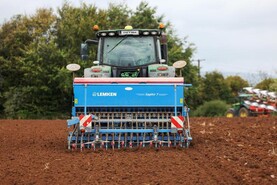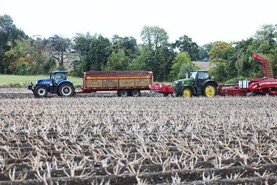Long, dry, unbroken days for harvesting seem a thing of the past. Day length is visibly shorter and any harvesting opportunity has become noticeably shorter with drizzle or light rain at night a common recent feature.
Straw baling has also become much more difficult where the baler cannot travel directly behind the combine. The risk of some wet getting into rows of straw has increased greatly and baling gets more troublesome when this happens as at least part of the crop will have to be shaken up to enable it to dry for baling.
Most areas have received rain now and some of the falls have been significant. Some areas have received more than their normal August rainfall while other areas are still only about half. The nature of the rain is what is causing the problems as much of what is falling is continuous light soaking rain and this is not helping the situation with straw breakdown.
Early finish
While there is still a tail on proceedings, we are definitely within the last 20% or less at this point. There is now relatively little still to be cut in the south and east but there are always some pockets remaining. For very many growers, 2018 will be the earliest completion date for harvest that they can remember.
Demand for straw remains strong but some of the heat seems to have gone out of the market
There is still a bit of winter wheat to be harvested and this is noticeably darkening in colour now as saprophytes begin to grow on over-ripe straw and ears. Yields from this crop definitely improved as the season progressed with many later crops passing the four-tonne mark.
If the weather for week ahead remains fine and good, it is likely that there will be very little left standing by this weekend.
A number of spring bean crops have gone under the knife in recent days and yields were unsurprisingly disappointing. Reported yield vary from 0.7 to 1.0t/ac. While we expect that many crops will be better than these, the crop will have a very disappointing year and average yield levels will likely see an all-time low as a result of the hot and dry conditions.
Moisture and quality
Most aspects of grain and straw yields and quality are as in previous weeks. Yields are back and spring barley seems worst affected. But the standard comment is that grain quality is generally good, making the common link between grain quality and yield difficult to explain.
In general, specific weights are generally higher in dry seasons but the levels recorded have been greatly helped by the low harvest moistures. Grain size is often small and this may still be indicative of the fact that yield was mainly limited by lack of grain fill, most likely caused by drought stress, and if good grain fill had been achieved to give 3t plus crops, it is likely that spring barley specific weights would have been 68 and well into the 70s for KPH.
Straw
Demand for straw remains strong but some of the heat seems to have gone out of the market. Straw yields have been good in the better winter wheat crops but yields are definitely back in the big spring barley crop. But still many growers now report six to eight round bales per acre.
In the past week, barley straw has traded at between €25/4x4 bale for local regular customers to around €40/t in some deficit regions of the country. But the majority of trade still lies between €30 and €35 ex-field.
Read more
Harvest 18: rain halts harvest progress in areas
Long, dry, unbroken days for harvesting seem a thing of the past. Day length is visibly shorter and any harvesting opportunity has become noticeably shorter with drizzle or light rain at night a common recent feature.
Straw baling has also become much more difficult where the baler cannot travel directly behind the combine. The risk of some wet getting into rows of straw has increased greatly and baling gets more troublesome when this happens as at least part of the crop will have to be shaken up to enable it to dry for baling.
Most areas have received rain now and some of the falls have been significant. Some areas have received more than their normal August rainfall while other areas are still only about half. The nature of the rain is what is causing the problems as much of what is falling is continuous light soaking rain and this is not helping the situation with straw breakdown.
Early finish
While there is still a tail on proceedings, we are definitely within the last 20% or less at this point. There is now relatively little still to be cut in the south and east but there are always some pockets remaining. For very many growers, 2018 will be the earliest completion date for harvest that they can remember.
Demand for straw remains strong but some of the heat seems to have gone out of the market
There is still a bit of winter wheat to be harvested and this is noticeably darkening in colour now as saprophytes begin to grow on over-ripe straw and ears. Yields from this crop definitely improved as the season progressed with many later crops passing the four-tonne mark.
If the weather for week ahead remains fine and good, it is likely that there will be very little left standing by this weekend.
A number of spring bean crops have gone under the knife in recent days and yields were unsurprisingly disappointing. Reported yield vary from 0.7 to 1.0t/ac. While we expect that many crops will be better than these, the crop will have a very disappointing year and average yield levels will likely see an all-time low as a result of the hot and dry conditions.
Moisture and quality
Most aspects of grain and straw yields and quality are as in previous weeks. Yields are back and spring barley seems worst affected. But the standard comment is that grain quality is generally good, making the common link between grain quality and yield difficult to explain.
In general, specific weights are generally higher in dry seasons but the levels recorded have been greatly helped by the low harvest moistures. Grain size is often small and this may still be indicative of the fact that yield was mainly limited by lack of grain fill, most likely caused by drought stress, and if good grain fill had been achieved to give 3t plus crops, it is likely that spring barley specific weights would have been 68 and well into the 70s for KPH.
Straw
Demand for straw remains strong but some of the heat seems to have gone out of the market. Straw yields have been good in the better winter wheat crops but yields are definitely back in the big spring barley crop. But still many growers now report six to eight round bales per acre.
In the past week, barley straw has traded at between €25/4x4 bale for local regular customers to around €40/t in some deficit regions of the country. But the majority of trade still lies between €30 and €35 ex-field.
Read more
Harvest 18: rain halts harvest progress in areas






 This is a subscriber-only article
This is a subscriber-only article










SHARING OPTIONS: